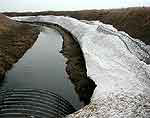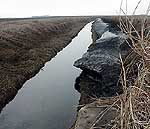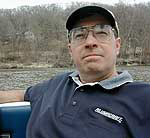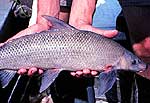By Mark Steil
Minnesota Public Radio
May 6, 2002
The Minnesota River is one of the largest streams in the state - and one of the dirtiest. Ten years ago, Minnesota's then-governor, Arne Carlson, announced an ambitious plan to clean up its muddy waters. His goal was to make the river "swimmable and fishable" in a decade. Those 10 years are almost up. Progress has been made but more work remains.
| |||
| |
|
||
|
|||
The Minnesota River is an eye-catcher. High bluffs flank the valley as the river passes by New Ulm. Hardwood trees carpet the steep hills leading to the water.
Scott Sparlin loves to explore the Minnesota River. Flocks of migrating ducks flush as Sparlin guides his boat on the river near New Ulm. A bald eagle nest dominates a shoreline tree. The air carries the tang of spring - runoff, wet soil, new vegetation. Sparlin points to a spot near shore which holds a special memory.
"Here's a great fishing spot up here on the right hand side," Sparlin says. "I've caught everything from soup to nuts on this one."
The scene is almost perfect, except for the water. It's a muddy brown - laden with soil, farm chemicals and urban runoff. But Sparlin says it's not nearly as bad as it was 10 years ago.
"There's no doubt about it. There's more translucency to that water. It looks a lot better," Sparlin says.
| |
|
|
|
||
Sparlin has worked on the Minnesota River cleanup for more than a dozen years. He helped start the first citizen's group on the issue, the Coalition for a Clean Minnesota River. As his boat passes the remains of a railroad bridge, he points out one reason the river is cleaner. Trees and grass cover what used to be a soybean field.
"What you got now is water that's being purified and filtered by all that perpetual cover and vegetation that's down there," Sparlin says.
Hundreds of square miles of farm land in the Minnesota River watershed have been taken out of production. Various state and federal programs pay farmers to idle the land. This reduces the amount of soil and fertilizer reaching the river.
Farmers are also taking steps to slow erosion on fields still used for crops. Many leave more plant residue on the soil to protect against wind and water. Larry Gunderson of the Minnesota Pollution Control Agency says changes in farming have reduced sediment in the river.
"Looking at the flows of the '70s and comparing them to similar flows in the 1990s, there was an approximately 25 percent reduction in sediment," Gunderson says.
| |
|
|
|
||
The cleanup has cost millions of dollars. The price tag for one government program alone is $250 million. The Conservation Reserve Enhancement Program pays for erosion control on 160 square miles of land in the Minnesota River watershed. The mix of cropland, hills and wetlands will become a wild area covered with grass and trees.
Farmers like the payments because they're a guaranteed source of income in a troubled agricultural economy. Jack Christensen, who farms near Milroy, says reducing runoff is something all farmers should do.
"The benefits are well known - it's just a matter of whether you're going to do it," says Christensen. "Whether you're going to make the committment, and maybe sacrifice just a little bit for the future."
Christensen has built tree lines to stop wind erosion. He's planted grass buffer strips near streams to filter runoff. He gets government money for some of the work, but not everything.
| |
|
|
|
||
Christensen would like to do more, but says the economics of farming prevent it. He says farmers are forced to plant every inch of every acre to stay in business. If the government didn't pay him, Christensen says he'd have to drop some erosion measures.
"If you don't have an incentive to do it - a payment incentive - you probably won't. I hate to say it, it's probably greedy sounding, but that's how it is," Christensen says.
So far, there's been plenty of government money to keep the Minnesota River cleanup moving forward. But some wonder if the money is being spent wisely. A few favor a targeted cleanup. Instead of trying to improve every tributary, they say efforts should focus on the worst pollution.
University of Minnesota professor David Mulla studied how the river changed over a 20-year period, from the 1970s to the 1990s. He found sediment declined about 20 percent, phosphorus by about 10 percent. But bacteria problems continue.
Runoff from livestock manure and sub-standard sewage systems sometimes push the level of dangerous bacteria above clean water threshholds. But overall, Mulla says the Minnesota River cleanup is heading in the right direction.
"I think the river has become significantly cleaner," Mulla says. "I think we still have a long time ahead of us though, before the river actually meets its goal of being swimmable and fishable."
| |
|
|
|
||
His most important finding started a debate that still continues - where does the pollution comes from? He calculated that two-thirds of sediment and phosphorus in the river comes from a relatively small area. A large part of it comes from two very dirty tributaries - the Blue Earth and the Le Sueur. They join near Mankato before entering the Minnesota River.
Another major pollution source is direct runoff into the river from Mankato downstream, to the Mississippi River. Steep hillsides there quickly channel muddy runoff into the Minnesota. The information lead Mulla to this conclusion.
"I just felt that more money needed to be spent in the three watersheds that produce most of the pollution, and less money needed to be spent in the nine watersheds that produce less of the pollution," says Mulla.
But some people don't like that message. River activist Scott Sparlin says the western part of the Minnesota River watershed, upstream from Mankato, needs to be cleaned up too. He says even if the Mankato-to-Twin Cities segment were erosion-free, runoff from the west would be enough to muddy the entire length of the river.
"It would still be an incredible pollution load, which would be many, many, many, many times over state and federal standards for water quality," Sparlin says.
| |
|
|
|
||
Whether the cleanup money is targeted or not, the University of Minnesota's David Mulla says water quality gains will be more difficult in the future. That's because most obvious problems, like industrial waste and sewage plants, have been fixed.
Changes in farming are the most likely source of future water quality improvements. Mulla says river sediment could be reduced another 16 percent, if more farmers left more crop residue on their fields after harvest.
But the signs of a cleaner river are showing up. Konrad Schmidt of the Minnesota Department of Natural Resources is happy that one of the state's rarest fish, the blue sucker, is reproducing in the Minnesota River.
"The males, in the spring when they're spawning, become almost a sky blue in color," Schmidt says. "It really is a beautiful fish."
The blue sucker has been absent from the river for decades. Schmidt says sediment is a big problem for the blue sucker, so its return signals improved water quality.
But even if the river is declared "clean", the work is not over. Just as the Minnesota River is always changing, the cleanup effort will evolve. It must guard hard-won gains and protect against future threats.
More Information





